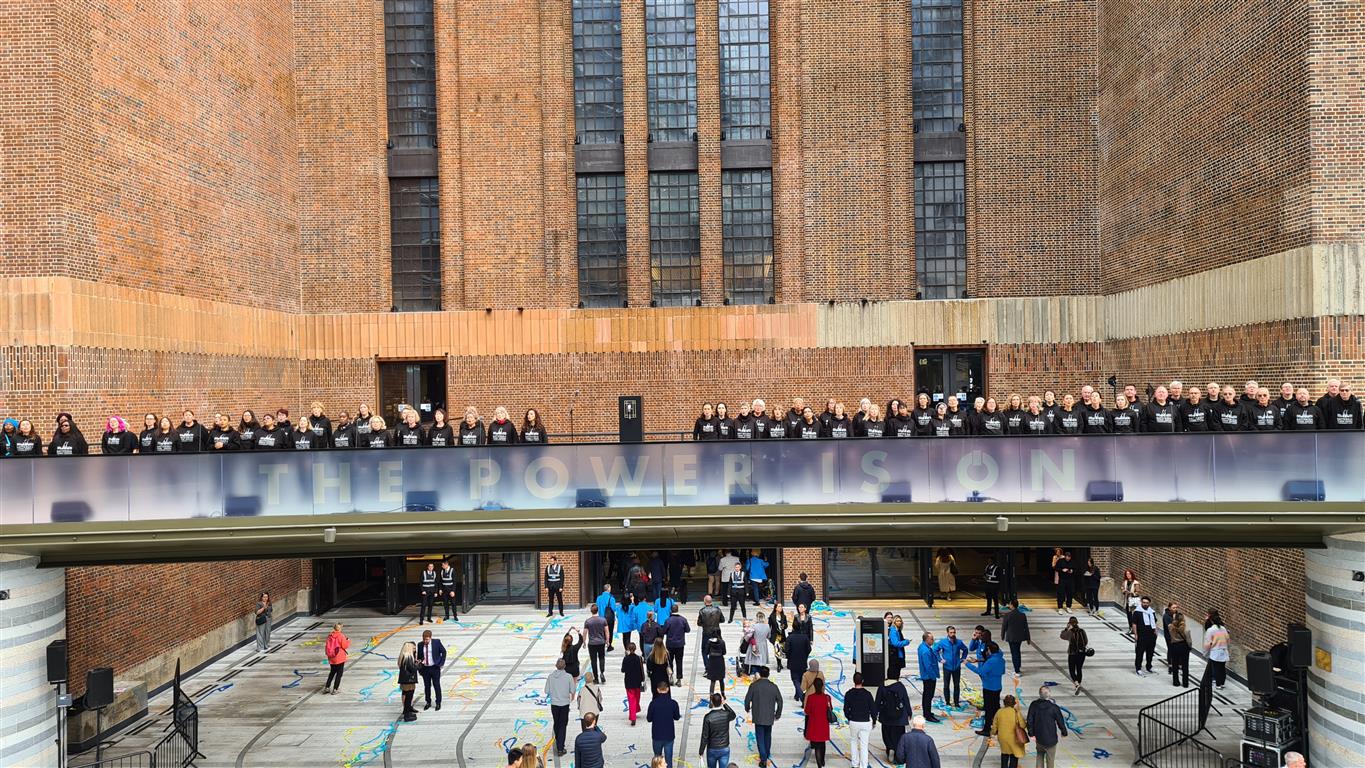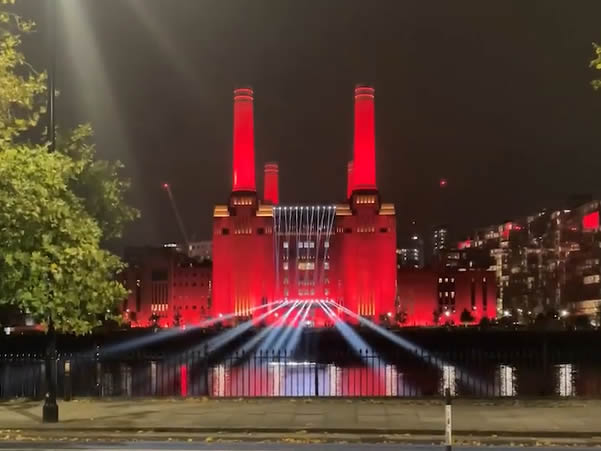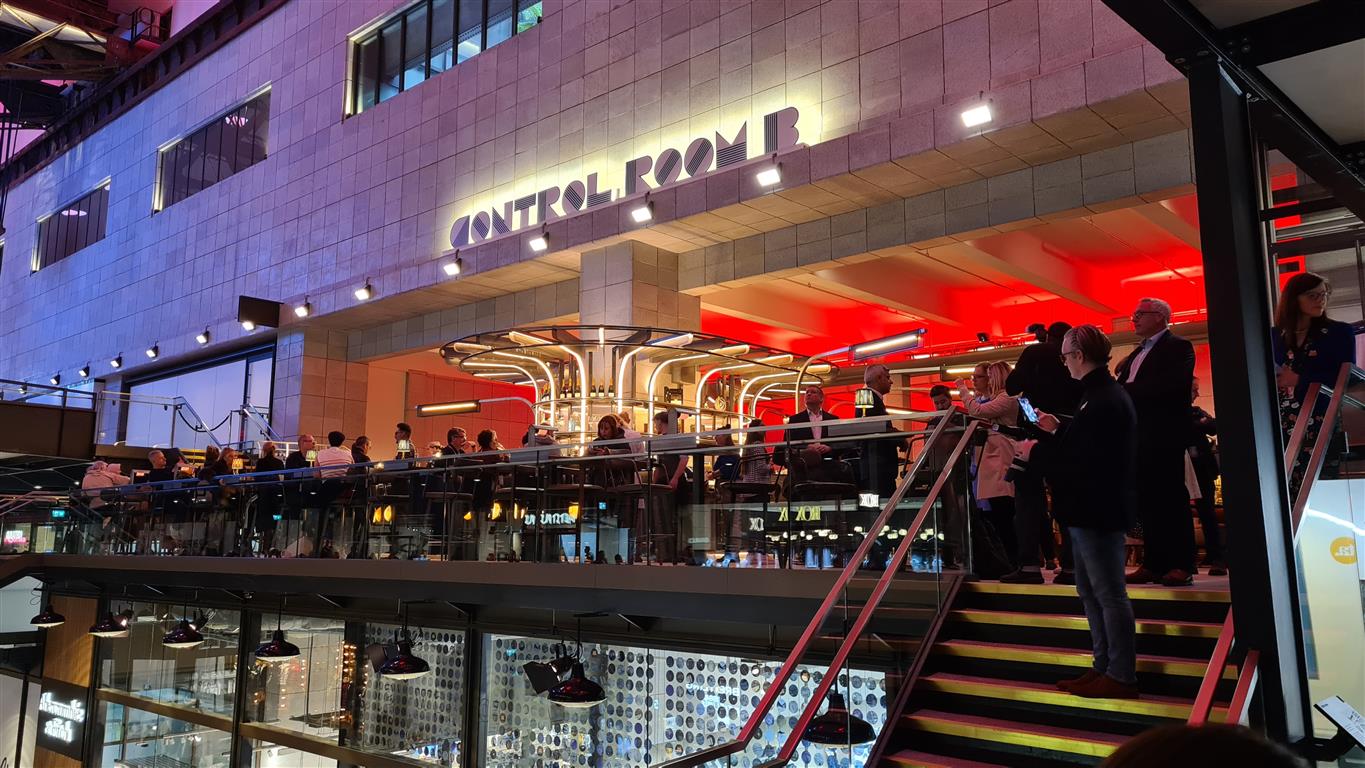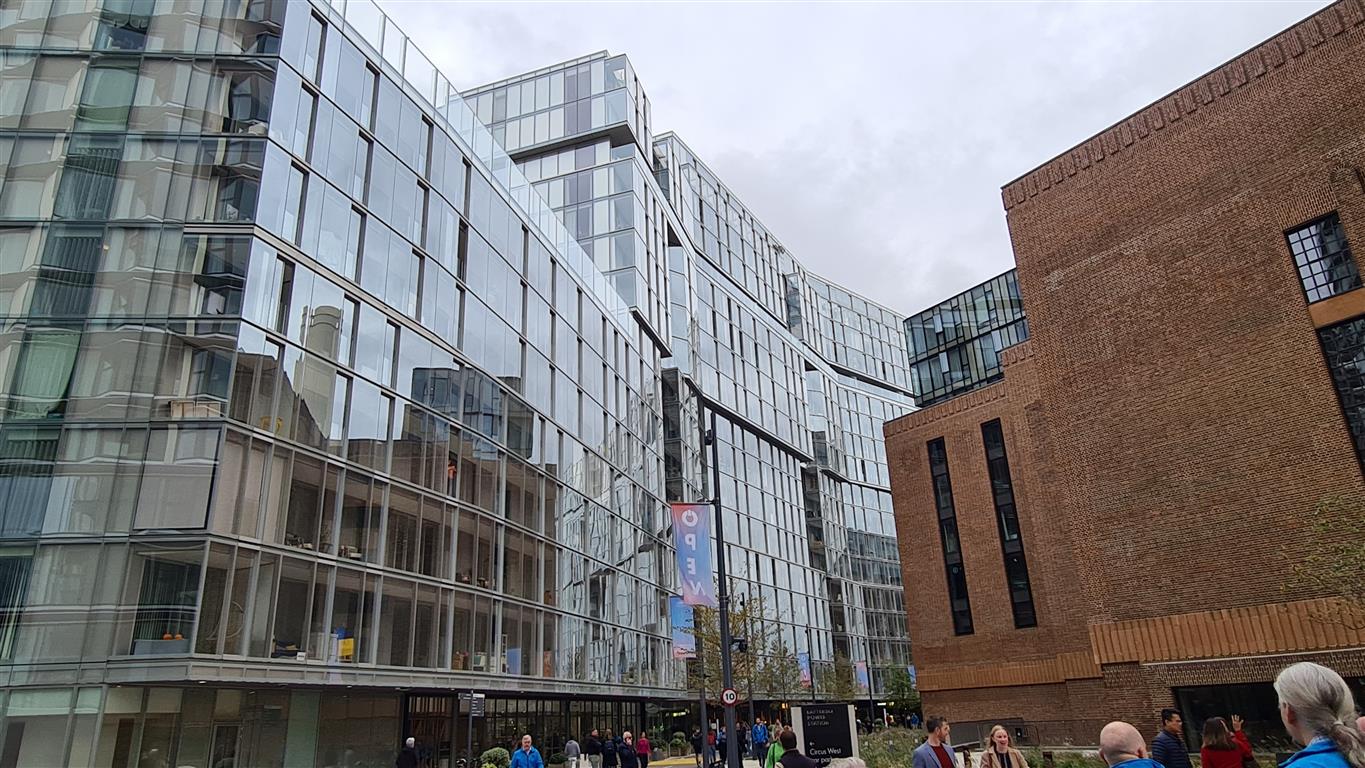The restored Grade II* Listed landmark opened to the public on Friday, October 14, nearly four decades after the closure of the Battersea Power Station.
People attended massively for the public opening
The ceremony organised for the opening to the public of the famous building attracted a large crowd, with journalists and TVs attending from around the world.

The events were organised on Malaysia Square on the south side of the Power Station, as a tribute to its owners who have made possible the impressive renovation of the Grade II* building through their investment.

Battersea MP Marsha de Cordova gave a speech, followed by Sadiq Kahn, mayor of London.

A few minutes before 10am started the countdown, party streamers were projected and fireworks came out from the roof.



A “private” opening on Wednesday
But in fact the official opening happened two days before, on Wednesday 12th, when Malaysian King Al-Sultan Abdullah (also called The Yang di-Pertuan Agong) officiated the opening ceremony of the Malaysian building in Central London, ahead of its public launch this Friday.

The King was accompanied by Queen Tunku Azizah, along with Malaysian Finance Minister, High Commissioner of Malaysia in the United Kingdom, UK Minister for Investment Dominic Johnson and UK Minister for Trade Policy Greg Hands.
The King officiated the opening of the Battersea Power Station by symbolically turning the power back on in Turbine Hall A, which has been inactive for over 40 years and will now house part of the power station’s retail offering. He also unveiled a plaque commemorating the visit.
In 2019, Malaysia’s leading fund management companies, PNB and EPF (Employees’ Provident Fund), became long-term holders of commercial assets, ensuring the landmark’s future for many generations to come.
The High Commissioner of Malaysia, Datuk Zakri Jaafar, said that the reopening of the landmark was a testament of Malaysia ability to conduct such a major project and hope it could lead to others:
“This is an outstanding achievement and represents the close bilateral, economic and investment ties between Malaysia and the UK”.
EPF Managing Director Datuk Seri Amir Hamzah Azizan said the conversion of a former coal-fired power station into an integrated residential, retail and leisure destination, also capable of delivering sustainable energy, is a very important milestone in the history of property development in London.
History of the building
The station is one of the world’s largest brick buildings and notable for its original, Art Deco interior fittings and decor.
As you can imagine, the decision to build a massive electric power station in the centre of London in 1927 was not very popular. Opposition was overcome by hiring Sir Giles Gilbert Scott (the designer of the famous red telephone boxes) to design the building’s exterior. You can guess how successful was his work as he was later asked to design another London power station, Bankside, which now houses the Tate Modern art gallery.

It was originally built in two stages by the London Power Company (LPC): the first one was achieved in 1935, and the second one started in 1937 but was paused in 1941 due to the second world war, before to be eventually completed in 1955, forming the iconic four-chimney structure.

At its peak in the 1960s, Battersea Power Station produced a fifth of London’s electricity.
The power station was decommissioned between 1975 (for Turbine Hall A) and 1983 (for Turbine Hall B) and until 2014 nothing was done while the building felt into ruins.

It was famously pictured on the cover of the Pink Floyd’s album ‘Animals’ in 1977…
… and used in some movies such as MacGyver in 1994 (where the plot established the Balkan Peninsula inside the large derelict building).
The station was also used for different venues such as a motorbike stunt competition in 2009 and for the launch of the Conservative Party’s 2010 general election manifesto in 2010.
In 2010 I launched the @Conservatives election manifesto in the shell of a ruined @BatterseaPwrStn, disused since 1983. Just three years later, I took part in the official ground-breaking ceremony, and I am delighted that this week, the redeveloped site is to formally open. 1/2 pic.twitter.com/VLNK0SmgJL
— David Cameron (@David_Cameron) October 11, 2022
The hiccups of its redevelopment
Since its closure, the building had different plans made up by successive site owners.
In 1984, a competition was organized to determine future use and this was won by a consortium with proposals for an indoor theme park. Planning approval was secured in 1986 and demolition and decontamination programs were completed. Some foundation work began (they even removed completely the middle roof and the main part of the building, the Boiler House, became effectively a shell on open air), but funding ran out in 1989 and the project could not proceed.

In 1993, Parkview International, a Hong Kong company, purchased the site. They announced in 1996 that they had secured a right to develop a 5-star hotel in the Battersea Power Station site and the work was expected to start in 1998. Detailed planning consent was granted in 2000 and 2001, but eventually stalled in 2004.

In 2006 the site was acquiert for £400 million by Irish company Real Estate Opportunities (REO) and Treasury Holdings. ROE’s plan included a huge glass eco-tower of 300 meters (equivalent of 100 storeys!), designed by Viñoly (the architect of the Walkie Talkie in the city, which faulty design concentrates heat on sunny day and burns things on the street at its bottom, the same one who also said that the view from the Tower of London was already ruined so who cares).

At the time, Rob Tincknell, managing director of Treasury Holdings, said : “it is either the go-ahead for the glass tower, or the power station may be doomed“. However, it was subsequently reviewed to cut 50 meters and be 250 m tall. Boris Johnson then London’s mayor called it an “inverted toilet-roll holder” and the tower was later dropped completely from the proposal.

The ROE scheme got planning consent from Wandsworth Council in 2010 but the company ran into trouble after the 2009 financial crisis and its debt made the company unable to pursue its plans.
In 2012, a new plan was proposed by Sir Terry Farrell’s architectural firm, which included an “urban park” and the demolition of all parts but the central piece with the four chimneys. That plan was always unlikely to go anywhere as the building was Listed Grade II*.
The site was then put up for sale in 2012 and acquired by Malaysian developers SP Setia and Sime Darby for £400 million (the same price as 2006), including a contribution of £100 million in provision for the Northern Line extension.
Eventually, it changed hands again in 2018 and was sold by the two companies to Malaysian government-backed investors (which includes EPFM, a private pension fund) for £1.6 billion. as the cost of renovation was spiralling.
The plan included not only the restoration of the historic building (housing a mix of luxury shops, cafes, restaurants, office space and residential accommodation) but also adjoining buildings (Circus West Village and others), a river path and a street to join the tube station.
Apple London should be moving to the 50,000 sqm of offices they hire in the new building in a few months (40% of the total office space). It is expected all the firm’s “central function” staff in London (more than 1000 people) in areas such as finance and human resources will move to the power station.

The Malaysian consortium of investors hired architects Wilkinson Eyre to take care of the renovation of the listed building, which was not much more than a derelict massive brick structure 10 years ago, with grass growing and no roof in the middle.
The total cost of the project (which includes all the surrounding buildings) is close to £9 billon (the restoration of the listed building alone is said to cost £1.15bn, much more than the £750m originally forecasted) and the Malaysian owners expect to receive about £100m a year in commercial rent.
A shopping mall as a mix of Westfield and St Pancras…
The main entrance is from the “boiler room” at the center of the building. The vast central area is mainly dedicated to an atrium on the upper floors to provide light for the office space located in both parts underneath the chimneys.
The public will follow corridors to the two turbine halls on the right and left of the centre core, which have been transformed into shopping malls.

Turbine A Hall on the west side of the building was the first to be built nearly one century ago, and its Art Deco style has been perfectly renovated and persevered.
The work made by architects Wilkinson Eyre must be applauded: they have preserved the main characteristics of the listed building with the original stones, old pillars, some rusty metal pieces and parts of the steelwork left exposed, and the restoration of both Control Rooms is impressive.




The A Station Control Room was built with many Art Deco fittings including wooden floor, glass roof and the use of Italian marble. A lot of attention has been taken to renovating the room to make a unique feature and vibrant memory of what was the purpose of the building. The semi-circular control desk as well as all the switchboards and the synchroscopes where carefully restored. It’s set to be used as an events venue.

On the east side of the building you will find another shopping mall in Turbine B Hall. It was originally achieved after the second world war and does not have the grandiose architecture of the earliest hall.



The control room of Turbine B Hall has now been transformed into a trendy cocktail bar.


For the general public, the Battersea Power Station will summarize as a large shopping mall, similar to Westfields for the brands that you can find there, and with a style that can be seen at St Pancras station.
You will find Ralph Lauren, Mulberry and Reiss, Nike, Adidas, Mango as well as Uniqlo, Calvin Klein, Tommy Hilfiger, The Kooples, Gant, Lacoste and many more.
From the entrance, there can be no doubt that we are talking about a place for luxury: Rolex, Cartier, Omega… make your choice.





…surrounded by buildings designed by famous architects
The Architectural Record magazine pointed at the detailed care given to the renovation of the Power Station and the thoughtful historical reuse, and the little attention to its surrounding. They said:
“Given the attention to detail in the historical fabric of the Switch House—in the ingenious and very successful use of a series of brick blends on the façade, for just one example —it is incongruous that little consideration has been given to the legibility of the historical structure within the surrounding area.”
Indeed, you won’t see much of the grandiose Grade II* building unless you stand right in front of it or on the riverside. All the other sides of Sir Giles Gilbert Scott magnificent construction have been hidden with other “designer’s” buildings. Gehry, Foster, Rogers, Simpson Haugh… a true “competition of architects” as once said Simon Jenkins, or “architectural masterpiece” as the project team names it on their website.
Just in front of the south side of the Power Station, Gehry has designed a cluster of five residential buildings, with his signature rippled facades, known as Prospect Place. From some angles, you might be able to spot one of the chimney of the Grade II*.


On its left, Foster has developed one large apartment block known as The Skyline, an undulating building enveloping the west side of the Gehry’s development and also making sure that there is no view left of this side of the listed building.
In between the two constructions of the world famours architects is a pedestrianised street, known as The “Electric Boulevard” (a huge overstatement for what is merely a simple paved path leading to the South entrance of the Power station).

When you eventually reach the South side of Battersea Power Station, the difference between the modern glass buildings and the imposant brick construction is striking.

The west side of the power station is obscured with the Circus West Village development designed by Ian Simpson and Rachel Haugh. In 2017, it received the Carbuncle Cup, an architecture award for “Britain’s worst building”, an “honour” given out annually by Building Design magazine. The online magazine said:
“Perhaps Wandsworth’s planning committee gave too much credence to the “artist’s impression” CGIs which bear little resemblance to the finished building.”

Surely, the job was not to hide and erase the listed building, but to make it shine. However, most of the buildings designed to surround the Power Station are taller that its brick structure. Building Design adds:
“This scale of overdevelopment has been forced on the power station because of some bad deals made by a series of owners needing to recoup massive investments.”
The buildings are so close together that Circus West Village residents will easily be able to chat with their front neighbours from the luxury flats of the Power Station, through their balconies!
Last but not least, there might be a feature of the 21st century, where people no longer have an expectation of privacy (as Facebook boss Mark Zuckerberg once said). The buildings ressemble a giant fish tank where you don’t need to go to Instagram or Youtube to binge intimate life, you only look at the façade of apartments.



The controversy about this development
The architects were allowed to add three glazed floors on top of the old brick structure. Private apartments are located on the upper floors of the structures as well as on the former power rooms on both sides of the building.
All new upper floors consist of extreme-luxurious apartments on one or two levels, with as many as four bedrooms, most with their own private terraces, roof gardens, or both.

If you have a lower budget however, you might be able to afford a studio flat for about £800,000.
If you prefer to live in the Foster’s Skyline or Gehry’s Prospect Place, it won’t be cheaper as it comes with a first-class 24-hour concierge, on-site gym, a rooftop infinity pool, spa, cinema, games room, meeting room and a 250-square-meter roof garden. A 1-bedroom flat is advertised £900,000.

In addition, expect to pay £700-£1000 per months as building charges to maintain all those facilities.
The rise of skyscrapers and luxury flats was championed by Edward Lister, former leader of Wandsworth council and later Boris Johnson’s close aide. One of Ed Lister main idea was to compensate low Council Tax in his borough by “selling” right-to-build to major developments. Nine Elms was his big playground that could attract major investors pouring millions into the Council’s coffer. [1]
Town planning, articulate development, affordable homes for people who need it have never been in the agenda, rather the opposite. Hubris, luxury and gentrification have been a mark of the past 15 years.
Nine Elms and the Battersea Power Station redevelopment project was Ed Lister’s baby and strongly supported by Wandsworth Conservatives.
In order to attract developers, they dropped the requirement of affordable housing provision (not only social, but including intermediate) from 33% which is the norm in the rest of the borough, to only 15% for the Nine Elms area.
The Malaysian developers of the Battersea Power Station got even a bigger “discount” and where allowed to drop to 9% on affordable housing (336 units instead of the initial 636 when the planning application was granted), claiming that the cost of the renovation was too expensive. And the affordable units won’t be at the Power station nor any of the luxurious building surrounding the area but on a remote site beside the busy railway line.
With such policy, and even with the lower amount of affordability granted to the Nine Elms area, Wandsworth has not been able to fulfil its global target of Social/Affordable Rent units for the last years as shown in one of our previous article.
The Financial Time said:
“Nine Elms and its surroundings have become notorious in London as a hyper-capitalist development experiment enabled by a laissez-faire attitude from the local authority, Wandsworth. Billed both as regeneration and housing provision, it is arguably neither of those things, but rather a privatisation of formerly public lands to create an ad hoc pile-up of towers which have little to do with their context or the pressing needs of London.”
Before last May local election, Wandsworth Labour leader Simon Hogg announced their (timid) plan to reform the local planning system. It included him saying: “No local councillor will accept gift as well as expensive meals from property developers“.
Therefore, with all the controversy in mind, it’s perhaps little surprise that the new Labour Councillors, who took control of Wandsworth Council at the last local election in May 2022, turned down the invitation to attend the public ceremony on Friday 14th.
The official reason given by the Council spokesperson is a bit ludicrous, saying that “Wandsworth Council said it had made it clear that neither the new administration nor senior council officers would “accept hospitality from property developers“. Indeed, Labour London Mayor Sadiq Kahn was there and eventually he will have the final word on many of the schemes still to be approved in Nine Elms.
We want Wandsworth residents to know that we are always negotiating the best deal for them.
Given there are currently numerous live planning applications from BPS that are still to be determined, it wouldn't be right to accept this hospitality. https://t.co/hJMXoZrKUb
— Aydin Dikerdem (@AydinDikerdem) October 10, 2022
Other Labour councillors said that they stayed away in protest of the project’s low level of social housing.
Battersea Power Station seems to have a cycle of 40 years. Produced electricity for about 40 years, was decommissioned and fell in ruins for another 40 years, before to raise to fame again with its full renovation. Will the current purpose last for another 40 years, only time will tell.
[1] Unfortunately, the current mayor of London Sadiq Kahn has not shown much more interest in buildings, cumulative impact, and London’s appearance. He seems to have no strategy for tall buildings and be only motivated by his political agenda on affordable accommodation: just provide enough of them and you will have his blessing, as shown a few years ago on the Homebase site in Wandsworth.
UPDATE 22/10/2022: Added the MacGyver Youtube extract where we can see the action inside the Battersea Power Station.






















